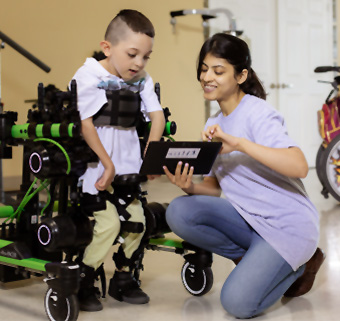Evidence Update: Perspectives on Selecting Gait Trainer Features
| September 2016 Once again Ginny Paleg, DScPT, MPT and Roslyn Livingstone, MSc have delivered a valuable literature review, this one on the all-important topic of gait training. In the therapy community we’re well aware of the importance of mobility for the developing mind and body. Because children with cerebral palsy at GMFCS levels IV and V are not independently mobile, supportive gait trainers provide critical therapy opportunities. While there are many adaptive gait trainers available, each with a wide variety of features and accessories, there is a lack of information or research to guide a clinician’s decision-making process when choosing between the various models. In fact, preliminary research suggests that gait trainers are chosen either because of familiarity or availability.
Once again Ginny Paleg, DScPT, MPT and Roslyn Livingstone, MSc have delivered a valuable literature review, this one on the all-important topic of gait training. In the therapy community we’re well aware of the importance of mobility for the developing mind and body. Because children with cerebral palsy at GMFCS levels IV and V are not independently mobile, supportive gait trainers provide critical therapy opportunities. While there are many adaptive gait trainers available, each with a wide variety of features and accessories, there is a lack of information or research to guide a clinician’s decision-making process when choosing between the various models. In fact, preliminary research suggests that gait trainers are chosen either because of familiarity or availability.
To assess the available evidence, researchers Paleg and Livingstone put together a literature review containing clinically grounded articles, case studies, surveys and expert opinion pertaining to gait trainer features and selection.
Considerations for Choosing Gait Trainer Features
It is clear from their findings that current evidence pertaining to the benefit of various gait trainer features is limited, divergent in areas and depends largely on the diagnosis of the client. Though it is difficult to summarize their findings, here are a few considerations I found particularly interesting:
- Posterior gait trainers encourage more upright posturing whereas anterior gait trainers are easier to transfer into.
- Flexible and dynamic pelvic supports may be most helpful for kids with dystonia or hypotonia and will contribute to more movement of the pelvis and rotation of the trunk.
- A forward-leaning position in a gait trainer contributes to stepping and moving forward whereas a more vertical position makes the device more maneuverable.
- Hands-free walkers contribute to arm swing and trunk rotation as well as increased participation and inclusion. Parents prefer hands-free walkers because they look more “typical.” But children with spasticity tend to relax more and step better when using arm supports.
This literature review is a welcome addition to the existing body of pediatric gait training research. Thank you Drs. Paleg and Livingstone!
Reference: Paleg G, Livingstone R. Evidence-informed clinical perspectives on selecting gait trainer features for children with cerebral palsy. Int J Ther Rehabil. 2016;23(8):444-54.




